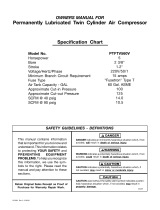
2. Circuitisnot used to supply any other electrical needs
(lights, appliances, etc.)
3. Extension cords comply with a 15 amp circuit breaker
or 15 amp time delay fuse.
4. Circuit is equipped with a 15 amp circuit breaker or
15 amp time delay fuse.
If any of the above conditions cannot be met, or if opera-
tion of the compressor repeatedly causes interruption of
power, it may be necessary to operate it from a 20 amp
circuit. It is not necessary to change the cord set.
Extension Cords
It is preferable to use extra air hose instead of an exten-
sion cord to avoid voltage drop and power loss to the
motor, and to prevent overheating.
If an extension cord must be used, be sure it is:
• 12 gauge (AWG) or heavier. (Wire size increases as
gauge number decreases. 10 AWG and 8 AWG
may also be used. DO NOT USE 14 OR 16 AWG.)
• a three-wire extension cord that has a three-connec
tor grounding plug, and a three-slot receptacle that
will accept the plug.
• no longer than 50 feet
• in good condition
Break-in Procedure
Serious damage may result if the following
break-in instructions are not closely fol-
lowed.
This procedure is required only once, before the air com-
pressor is put into service.
1. Set the pressure switch "AUTO/O" lever in the
"O" position for "Off".
2. Plug the power cord into the correct branch circuit
receptacle.
3. Do not attach hose to outlet. Leave the outlet open
to the atmosphere.
4. Turn the regulator clockwise, opening it fully, to
prevent air pressure build-up in the tank.
5. Move the "AUTO/O" lever to "AUTO". The com-
pressor will start.
6. RUN THE COMPRESSOR FOR 15 MINUTES.
Make sure the regulator is open and there is no tank
pressure build-up.
7. After 15 minutes, close the regulator by turning it
counterclockwise. The air tank will fill to cut-out
pressure and then the motor will stop.
1.
2
Before attaching air hose or accessories, make
sure the "AUTO/O" lever is set to "O" and the air
regulator is closed.
AKach hose and accessories.
TOO MUCH AIR PRESSURE CREATES A
HAZARDOUS RISK OF BURSTING. CARE-FULLY
FOLLOW STEPS 3 AND 5 BELOW EACH TIME
THE COMPRESSOR IS USED.
I!'_JLIJBL{e]_l
Compressed air from the outfit may contain water
condensation. Do not spray unfiltered air at an
item that could be damaged. Some air operated
tools or devices may require filtered air. Read the
instructions for the air tool or device.
3. Check the manufacturer's maximum pressure rating
for air tools and accessories. The regulator outlet
pressure must never exceed the maximum
pressure rating.
4. Turn the "AUTO/O" lever to "AUTO" and allow tank
pressure to build. Motor will stop when tank
pressure reaches "cut-out" pressure.
5. Open the regulator by turning it clockwise. Adjust
the reg_dator to the correct pressure setting. Your
compressor is ready for use. -*
6.
Always operate the air compressor in well-
ventilated areas; free of gasoline or other solvent
vapors. Do not operate the compressor near the
spray area.
WHEN YOU ARE FINISHED:
7. Set the "AUTO/O" lever to "O".
8. Turn the regulator counterclockwise and set the
outlet pressure to zero.
9. Remove the air tool or accessory.
- 10. Open-the regulator and allow the air to slowly
bleed from the tank. Close the regulator when
tank pressure is approximately 20 psi.
11. Drain water from air tank.
WATER WILL CONDENSE IN THE AIR TANK. IF
NOT DRAINED, WATER WILL CORRODE AND
WEAKEN THE AIR TANK CAUSING A RISK OF
AIR TANK RUPTURE.
12.
NOTE:
If drain cock valve is plugged, release all air
pressure. The valve can then be removed,
cleaned, then reinstalled.
After the water has been drained, close the drai,
valve. The air compressor can now be stored.
9 -- ENG
D20417 Rev.1 6/28/00













